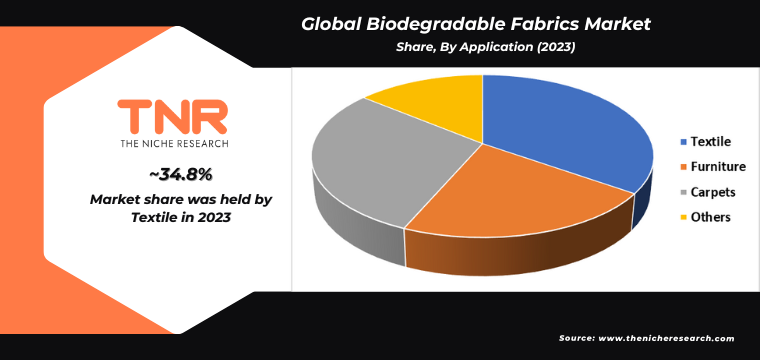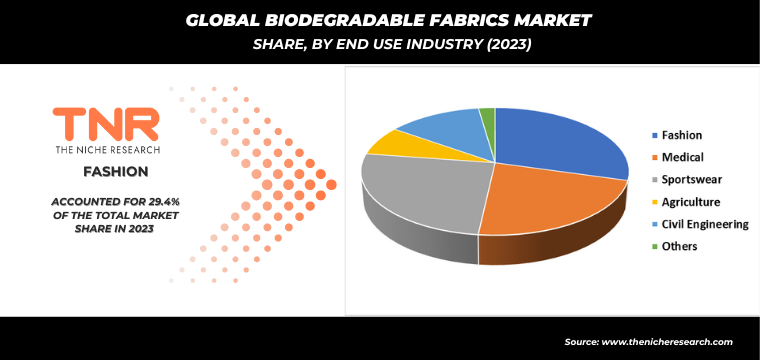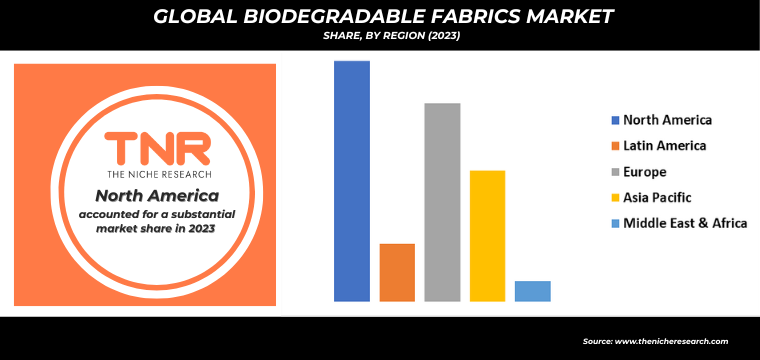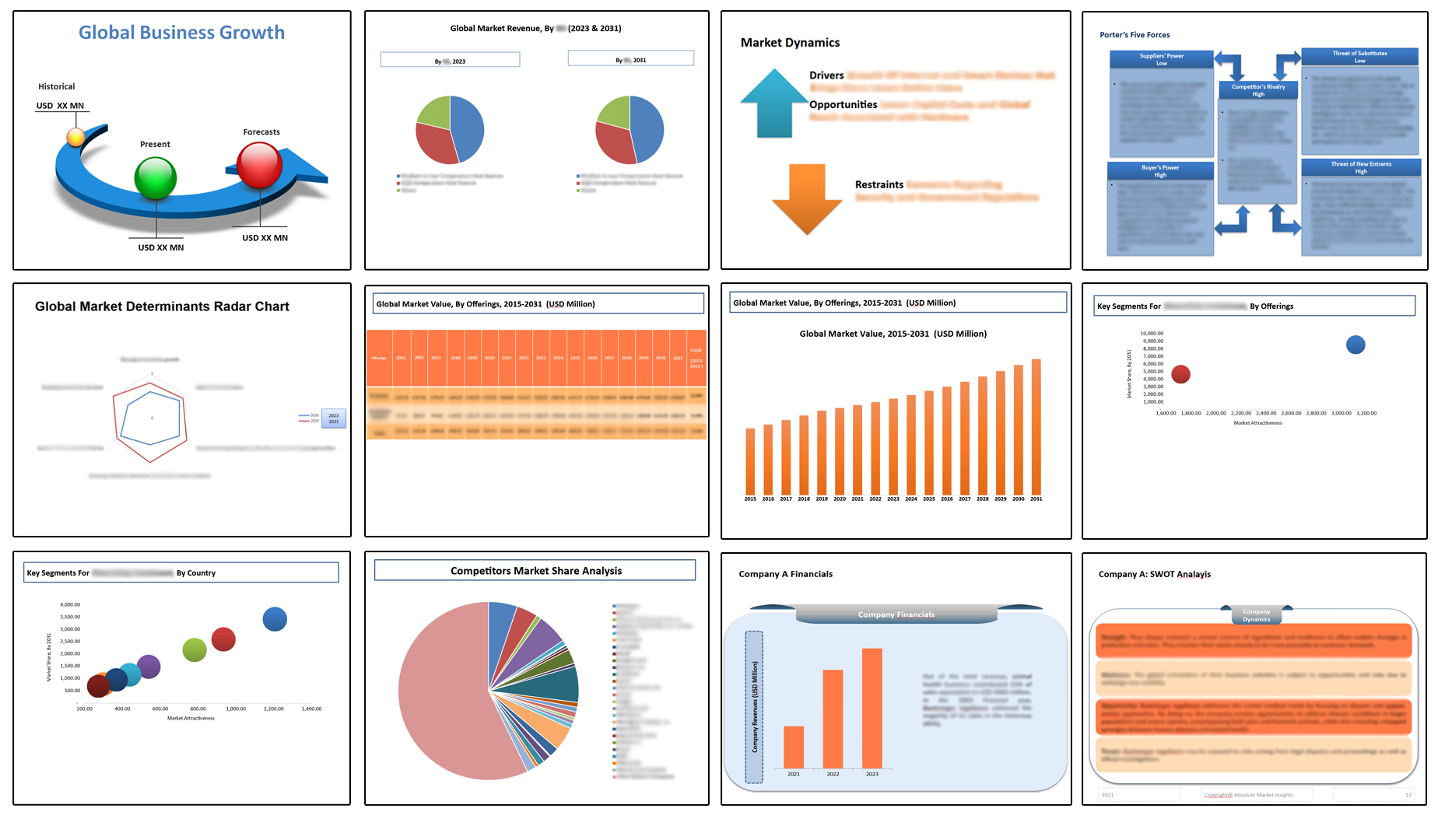Global Biodegradable Fabrics Market: By Product Type, By Application, By End Use Industry, By Region & Segmental Insights Trends and Forecast, 2024 – 2034
- Industry: Consumer Goods
- Report ID: TNR-110-1119
- Number of Pages: 420
- Table/Charts : Yes
- June, 2024
- Base Year : 2024
- No. of Companies : 10+
- No. of Countries : 29
- Views : 10160
- Covid Impact Covered: Yes
- War Impact Covered: Yes
- Formats : PDF, Excel, PPT
Biodegradable fabrics are textiles designed to decompose naturally into non-toxic components when exposed to environmental conditions such as moisture, air, and microbial activity. Unlike traditional synthetic fibres like polyester and nylon, which can persist in the environment for hundreds of years, biodegradable fabrics are made from natural fibres such as organic cotton, bamboo, hemp, and innovative bio-based polymers like polylactic acid (PLA). These materials break down into water, carbon dioxide, and biomass, leaving minimal environmental impact. The adoption of biodegradable fabrics is driven by growing environmental concerns and the demand for sustainable alternatives in the fashion industry and beyond.
These fabrics not only reduce the ecological footprint of products but also support a circular economy by promoting the use of renewable resources and waste reduction. As consumer awareness of environmental issues rises, biodegradable fabrics are becoming increasingly popular across various applications, including fashion, medical textiles, and packaging.
Biodegradable fabrics are increasingly in demand due to rising environmental awareness and regulatory pressures aimed at reducing plastic waste. Consumers, particularly younger generations, are prioritizing sustainable products, driving the fashion and textile industries to adopt eco-friendly materials like organic cotton, bamboo, hemp, and polylactic acid (PLA). However, the higher production costs and limited availability of raw materials pose significant restraints, making biodegradable fabrics more expensive than their conventional counterparts. Despite these challenges, technological advancements are creating opportunities by enhancing the properties and affordability of biodegradable textiles, making them more competitive in the market.
Additionally, growing support for corporate social responsibility (CSR) and sustainability initiatives from both companies and governments is fostering a favorable environment for the expansion of biodegradable fabrics. This convergence of consumer demand, innovation, and regulatory support is propelling the market forward, highlighting the potential for biodegradable fabrics to significantly reduce the environmental impact of the textile industry while meeting evolving market expectations.
In terms of revenue, the global biodegradable fabrics market was worth US$ 5.93 Bn in 2023, anticipated to witness CAGR of 12.2% during 2024 – 2034.

Global Biodegradable Fabrics Market Dynamics
Consumer Awareness and Demand: Increasing environmental consciousness among consumers, especially millennials and Gen Z, is significantly boosting demand for sustainable and eco-friendly products. This shift in consumer preferences is prompting industries to adopt biodegradable fabrics. Governments worldwide are implementing stricter environmental regulations to reduce plastic waste and pollution. Policies promoting sustainability and the use of renewable resources are encouraging manufacturers to switch to biodegradable fabrics.
Technological Advancements: Innovations in textile technology are improving the properties of biodegradable fabrics, making them more durable, affordable, and comparable to traditional synthetic fabrics. Enhanced production techniques are also reducing costs and expanding applications. Companies are increasingly adopting CSR initiatives, aiming to minimize their environmental impact. The integration of biodegradable fabrics into product lines aligns with corporate sustainability goals and improves brand reputation.
Fashion Industry Trends: The fashion industry is a major driver of biodegradable fabric demand, with designers and brands incorporating sustainable materials into their collections to meet consumer expectations and regulatory requirements. The growing awareness and adoption of biodegradable fabrics in various sectors, including medical, sportswear, agriculture, and civil engineering, are expanding the market scope and creating new opportunities.
Supply Chain Integration: Improved supply chain processes and the availability of raw materials for producing biodegradable fabrics, such as PLA, organic cotton, and hemp, are facilitating market growth. Fluctuations in the prices of raw materials and the cost-effectiveness of biodegradable fabrics compared to conventional textiles can influence market dynamics. Economic incentives and subsidies for sustainable practices also play a role.

Polylactic Acid (PLA) Segment Has Garnered Major Market Share in the Global Biodegradable Fabrics Market During the Forecast Period (2024 – 2034).
Polylactic acid (PLA) is a key driver in the demand for biodegradable fabrics, primarily due to its eco-friendly properties and versatility. Derived from renewable resources like corn starch or sugarcane, PLA is highly biodegradable, breaking down into natural components under the right conditions. This characteristic makes it an attractive option for environmentally conscious consumers and companies seeking sustainable alternatives to traditional synthetic fibres like polyester.
The fashion industry’s growing commitment to reducing its environmental footprint has led to increased adoption of PLA in apparel and accessories. Additionally, advancements in PLA production have enhanced its strength, durability, and comfort, making it suitable for a wide range of textile applications. The combination of consumer demand for sustainability, regulatory pressures, and the fashion industry’s proactive approach to eco-friendly practices has solidified PLA’s position as a leading material in the biodegradable fabrics market.

By End Use Industry Fashion Industry had the Highest Share in the Global Biodegradable Fabrics Market in 2023.
In the fashion industry, the demand for biodegradable fabrics is driven by a growing consumer preference for sustainable and eco-friendly products. Increasing environmental awareness, especially among younger generations, has led to a surge in demand for clothing made from materials such as organic cotton, bamboo, and hemp. Brands are responding by incorporating these biodegradable fabrics into their collections to align with consumer values and reduce their environmental footprint. Additionally, regulatory pressures and corporate social responsibility initiatives are pushing the industry toward sustainable practices. High-profile endorsements and marketing campaigns further fuel this trend, making biodegradable fabrics a significant focus in fashion as companies strive to meet the evolving demands of an eco-conscious market.

By Region, North America Dominated the Biodegradable Fabrics Market in 2023.
In North America, the demand for biodegradable fabrics is driven primarily by increasing environmental awareness and regulatory pressures aimed at reducing plastic waste. Consumers are becoming more eco-conscious, seeking sustainable alternatives to conventional textiles that contribute to pollution. This shift is particularly evident among millennials and Gen Z, who prioritize eco-friendly products. Additionally, government regulations and initiatives promoting sustainability are pushing industries to adopt greener practices.
The fashion and textile industries are responding by incorporating biodegradable materials such as organic cotton, bamboo, and hemp into their products. Corporate social responsibility and the desire to meet consumer expectations are further propelling this trend. As a result, the market for biodegradable fabrics is expanding, supported by advancements in technology that enhance the durability and affordability of these materials. This confluence of consumer demand, regulatory influence, and technological innovation is shaping a more sustainable textile landscape in North America.

Competitive Landscape: Global Biodegradable Fabrics Market:
- David C. Poole
- Eco Textile
- Ecologic Fiber
- Enka Textile
- EnviroTextiles
- Greenfibres
- Hemp Inc
- Gore & Associates
- Propex
- Taiwan Singtex Industrial Company
- Tengri
- Vestagen Protective Technologies
- Other Industry Participants
Global Biodegradable Fabrics Market Scope
| Report Specifications | Details |
| Market Revenue in 2023 | US$ 5.93 Bn |
| Market Size Forecast by 2034 | US$ 21.04 Bn |
| Growth Rate (CAGR) | 12.2% |
| Historic Data | 2016 – 2022 |
| Base Year for Estimation | 2023 |
| Forecast Period | 2024 – 2034 |
| Report Inclusions | Market Size & Estimates, Market Dynamics, Competitive Scenario, Trends, Growth Factors, Market Determinants, Key Investment Segmentation, Product/Service/Solutions Benchmarking |
| Segments Covered | By Product Type, By Application, By End Use Industry, By Region |
| Regions Covered | North America, Europe, Asia Pacific, Middle East & Africa, Latin America |
| Countries Covered | U.S., Canada, Mexico, Rest of North America, France, The UK, Spain, Germany, Italy, Nordic Countries (Denmark, Finland, Iceland, Sweden, Norway), Benelux Union (Belgium, The Netherlands, Luxembourg), Rest of Europe, China, Japan, India, New Zealand, Australia, South Korea, Southeast Asia (Indonesia, Thailand, Malaysia, Singapore, Rest of Southeast Asia), Rest of Asia Pacific, Saudi Arabia, UAE, Egypt, Kuwait, South Africa, Rest of Middle East & Africa, Brazil, Argentina, Rest of Latin America |
| Key Players | David C. Poole, Eco Textile, Ecologic Fiber, Enka Textile, EnviroTextiles, Greenfibres, Hemp Inc, L. Gore & Associates, Propex, Taiwan Singtex Industrial Company, Tengri, Vestagen Protective Technologies |
| Customization Scope | Customization allows for the inclusion/modification of content pertaining to geographical regions, countries, and specific market segments. |
| Pricing & Procurement Options | Explore purchase options tailored to your specific research requirements |
| Contact Details | Consult With Our Expert
Japan (Toll-Free): +81 663-386-8111 South Korea (Toll-Free): +82-808- 703-126 Saudi Arabia (Toll-Free): +966 800-850-1643 United Kingdom: +44 753-710-5080 United States: +1 302-232-5106 E-mail: askanexpert@thenicheresearch.com
|
Global Biodegradable Fabrics Market
By Product Type
- Polyester
- Polylactic Acid (PLA)
- Cellulose,
- Natural Fiber
- Others
By Application
- Textile
- Furniture
- Carpets
- Others
By End Use Industry
- Fashion
- Medical
- Sportswear,
- Agriculture
- Civil Engineering
- Others
By Region
- North America (U.S., Canada, Mexico, Rest of North America)
- Europe (France, The UK, Spain, Germany, Italy, Nordic Countries (Denmark, Finland, Iceland, Sweden, Norway), Benelux Union (Belgium, The Netherlands, Luxembourg), Rest of Europe)
- Asia Pacific (China, Japan, India, New Zealand, Australia, South Korea, Southeast Asia (Indonesia, Thailand, Malaysia, Singapore, Rest of Southeast Asia), Rest of Asia Pacific)
- Middle East & Africa (Saudi Arabia, UAE, Egypt, Kuwait, South Africa, Rest of Middle East & Africa)
- Latin America (Brazil, Argentina, Rest of Latin America)
Report Layout:

Table of Contents
Note: This ToC is tentative and can be changed according to the research study conducted during the course of report completion.
**Exclusive for Multi-User and Enterprise User.
Global Biodegradable Fabrics Market
By Product Type
- Polyester
- Polylactic Acid (PLA)
- Cellulose,
- Natural Fiber
- Others
By Application
- Textile
- Furniture
- Carpets
- Others
By End Use Industry
- Fashion
- Medical
- Sportswear,
- Agriculture
- Civil Engineering
- Others
By Region
- North America (U.S., Canada, Mexico, Rest of North America)
- Europe (France, The UK, Spain, Germany, Italy, Nordic Countries (Denmark, Finland, Iceland, Sweden, Norway), Benelux Union (Belgium, The Netherlands, Luxembourg), Rest of Europe)
- Asia Pacific (China, Japan, India, New Zealand, Australia, South Korea, Southeast Asia (Indonesia, Thailand, Malaysia, Singapore, Rest of Southeast Asia), Rest of Asia Pacific)
- Middle East & Africa (Saudi Arabia, UAE, Egypt, Kuwait, South Africa, Rest of Middle East & Africa)
- Latin America (Brazil, Argentina, Rest of Latin America)
The Niche Research approach encompasses both primary and secondary research methods to provide comprehensive insights. While primary research is the cornerstone of our studies, we also incorporate secondary research sources such as company annual reports, premium industry databases, press releases, industry journals, and white papers.
Within our primary research, we actively engage with various industry stakeholders, conducting paid interviews and surveys. Our meticulous analysis extends to every market participant in major countries, allowing us to thoroughly examine their portfolios, calculate market shares, and segment revenues.
Our data collection primarily focuses on individual countries within our research scope, enabling us to estimate regional market sizes. Typically, we employ a bottom-up approach, meticulously tracking trends in different countries. We analyze growth drivers, constraints, technological innovations, and opportunities for each country, ultimately arriving at regional figures.Our process begins by examining the growth prospects of each country. Building upon these insights, we project growth and trends for the entire region. Finally, we utilize our proprietary model to refine estimations and forecasts.
Our data validation standards are integral to ensuring the reliability and accuracy of our research findings. Here’s a breakdown of our data validation processes and the stakeholders we engage with during our primary research:
- Supply Side Analysis: We initiate a supply side analysis by directly contacting market participants, through telephonic interviews and questionnaires containing both open-ended and close-ended questions. We gather information on their portfolios, segment revenues, developments, and growth strategies.
- Demand Side Analysis: To gain insights into adoption trends and consumer preferences, we reach out to target customers and users (non-vendors). This information forms a vital part of the qualitative analysis section of our reports, covering market dynamics, adoption trends, consumer behavior, spending patterns, and other related aspects.
- Consultant Insights: We tap into the expertise of our partner consultants from around the world to obtain their unique viewpoints and perspectives. Their insights contribute to a well-rounded understanding of the markets under investigation.
- In-House Validation: To ensure data accuracy and reliability, we conduct cross-validation of data points and information through our in-house team of consultants and utilize advanced data modeling tools for thorough verification.
The forecasts we provide are based on a comprehensive assessment of various factors, including:
- Market Trends and Past Performance (Last Five Years): We accurately analyze market trends and performance data from preceding five years to identify historical patterns and understand the market’s evolution.
- Historical Performance and Growth of Market Participants: We assess the historical performance and growth trajectories of key market participants. This analysis provides insights into the competitive landscape and individual company strategies.
- Market Determinants Impact Analysis (Next Eight Years): We conduct a rigorous analysis of the factors that are projected to influence the market over the next eight years. This includes assessing both internal and external determinants that can shape market dynamics.
- Drivers and Challenges for the Forecast Period:Identify the factors expected to drive market growth during the forecast period, as well as the challenges that the industry may face. This analysis aids in deriving an accurate growth rate projection.
- New Acquisitions, Collaborations, or Partnerships: We keep a close watch on any new acquisitions, collaborations, or partnerships within the industry. These developments can have a significant impact on market dynamics and competitiveness.
- Macro and Micro Factors Analysis:A thorough examination of both macro-level factors (e.g., economic trends, regulatory changes) and micro-level factors (e.g., technological advancements, consumer preferences) that may influence the market during the forecast period.
- End-User Sentiment Analysis: To understand the market from the end-user perspective, we conduct sentiment analysis. This involves assessing the sentiment, preferences, and feedback of the end-users, which can provide valuable insights into market trends.
- Perspective of Primary Participants: Insights gathered directly from primary research participants play a crucial role in shaping our forecasts. Their perspectives and experiences provide valuable qualitative data.
- Year-on-Year Growth Trend: We utilize a year-on-year growth trend based on historical market growth and expected future trends. This helps in formulating our growth projections, aligning them with the market’s historical performance.
Research process adopted by TNR involves multiple stages, including data collection, validation, quality checks, and presentation. It’s crucial that the data and information we provide add value to your existing market understanding and expertise. We have also established partnerships with business consulting, research, and survey organizations across regions and globally to collaborate on regional analysis and data validation, ensuring the highest level of accuracy and reliability in our reports.















